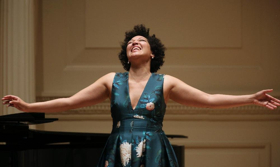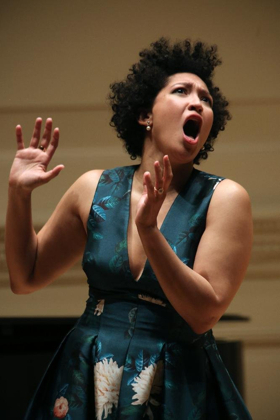Review: Have You Met Ms. BULLOCK? JULIA, That Is, At Carnegie's Weill Recital Hall

When the radiant, intellectual soprano Julia Bullock stepped on stage Carnegie Hall's intimate venue, Weill Recital Hall (just 268 seats), to wild applause, I felt like I was the only one hearing her "live" for the first time. Everyone else there seemed to have a personal relationship with her and her artistry.
I'd heard glimpses of her portrayal of Dame Shirley, whose writings are the heart of John Adams' GIRLS OF THE GOLDEN WEST, which she debuted in San Francisco last fall to much acclaim and in some YouTube clips. Otherwise, I'd somehow missed her "live," in previous recitals and in the title roles of CENDRILLON and CUNNING LITTLE VIXEN at Juilliard. My loss-and a significant one.
At Weill, we heard the side of Bullock that gives life to a variety of songs-no arias here, though she is known for a gamut of roles from Mozart to Adams (she's doing Kitty Oppenheimer at Santa Fe this summer), Gershwin to Stravinsky, Massenet to Janacek.

Photo: Steve J. Sherman
This concert was filled with a broad variety of treats, accompanied by John Arida on piano who also had a chance to show off some superlative work of his own. They ranged from the Schubert lieder and Barber's "Hermit Songs" to her encore numbers, the haunting "One by One" by Connie Converse (which, as Bullock posits, is reminiscent of Schubert) and the delicious "La Conga Blicoti," composed by Armando Orefiche for Josephine Baker. (Bullock has a special fondness for Baker, having premiered Tyshawn Sorey's "Portrait: Josephine Baker"--he wrote "Cycles of My Being" for Lawrence Brownlee, having its NY debut at Zankel Hall next week--at the Ojai Festival a few years ago).
She was, in a word, spectacular. Her affinity for the Schubert was remarkable, tossing off the songs as if she were a native speaker of German and commenting on the music as she went along. (Bullock also provided translations of the texts.) I could have listened to much more but was grateful for the few she included.
Bullock started off with "Suleika I," which Brahms called "the loveliest song ever written"--and immediately set a tone for the concert by correcting the mis-impression that the text was written by Goethe. Rather, she explained, it was written by Marianne von Willemer, who had a relationship with the famed poet. She put us on notice: No woman left behind in this concert. She sang that first Schubert with thoughtfulness and urgency, caressing the music at every turn and putting her whole body into it; she's not a performer who stands with hands neatly folded in front of her. She took on a new persona with every piece: lilting and almost jaunty in "Seligkeit," prayer-like in the Wandrers Nachlied II, caressing in Lachen und Weinen.
Finishing the first half of the program were Samuel Barber's "Hermit Songs," based on texts written by monks in the Middle Ages, speaking about their simple lives, and translated by a variety of writers. They debuted in 1953 with the then-unknown Leontyne Price and provided an opportunity for Bullock to show not only her expressiveness but her ability to turn on a dime, with songs short and long, religious and witty, declamatory and soaring. Bullock and Arida did some of their closest work here. I particularly like the brief, languorous "Church Bell at Night" and "Promiscuity," as well as the luxurious "The Monk and the Cat" with its odd sonorities.
The second half began with selections from Faure's "La Chanson d'Eve," and while Bullock's explanations were interesting, and she was moving in her in her interpretations, I can't say I warmed to the work itself. Much more compelling, for me, were her explorations into jazz and the blues written for or by black women (and Bullock's use of her increasingly mezzo-ish sound). How lucky we are that the days are gone when a "serious" singer wouldn't dare dip into this kind of repertoire, because Bullock was truly riveting here.
In "Driftin' Tide," written by the husband-wife team of Spencer Williams and Pat Castleton for Alberta Hunter, the singer was a low-key charmer, using a matter-of-fact style to tell about her resignation to "getting him back again." She then showed her sassy side in Maceo Pinkard's "You Can't Tell the Difference After Dark" (also recorded by Hunter), singing of the appeal of women who "may be brown as a berry." Hunter also provided another bluesy charmer for Bullock--this time, as coauthor with Lovie Austin--in "Downhearted Blues," which was a massive hit for Bessie Smith, making her a household name.
A Billie Holiday collaboration, "Our Love Is Different," provided Bullock with a seductive torch song, but it was a pair of Nina Simone compositions (the first co-written with Weldon Irvine Jr.) that provided an edgy triumph for her, though she had been hesitant about taking them on because of Simone's distinctive style: With "Revolution," she stripped away the arrangement and brilliantly sang it a capella. Bullock finished off the printed program with "Four Women"--showing the pain behind their cutesy names--before taking on those two encores mentioned earlier, but still leaving us wanting more.
Reader Reviews
Videos

